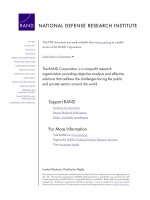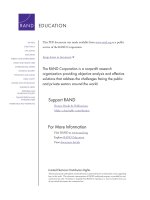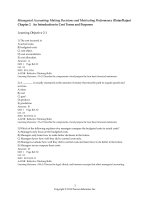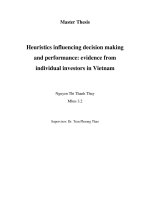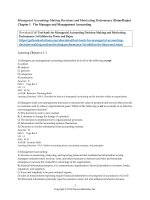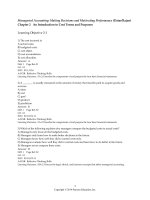Stregh in number how do data driven decision making affect firm performance
Bạn đang xem bản rút gọn của tài liệu. Xem và tải ngay bản đầy đủ của tài liệu tại đây (144.65 KB, 33 trang )
Strength in Numbers:
How Does Data-Driven Decisionmaking Affect Firm Performance?
Abstract
We examine whether firms that emphasize decision making based on data and business
analytics (“data driven decision making” or DDD) show higher performance. Using detailed
survey data on the business practices and information technology investments of 179 large
publicly traded firms, we find that firms that adopt DDD have output and productivity that is 56% higher than what would be expected given their other investments and information
technology usage. Furthermore, the relationship between DDD and performance also appears in
other performance measures such as asset utilization, return on equity and market value. Using
instrumental variables methods, we find evidence that the effect of DDD on the productivity do
not appear to be due to reverse causality. Our results provide some of the first large scale data on
the direct connection between data-driven decision making and firm performance.
Keywords: Business Analytics, Decisionmaking, Productivity, Profitability, Market Value
1
Acknowledgements: We thank Andrew McAfee, Roger Robert, Johnson Sikes and participants
at the Workshop for Information Systems and Economics and participants at the 9th Annual
Industrial Organization Conference for useful comments and the MIT Center for Digital
Business for generous financial support.
Strength in Numbers: How does data-driven decision-making affect firm
performance?
INTRODUCTION
How do firms make better decisions? In more and more companies, managerial decisions
rely less on a leader’s “gut instinct” and instead on data-based analytics. At the same time, we
have been witnessing a data revolution; firms gather extremely detailed data from and propagate
knowledge to their consumers, suppliers, alliance partners, and competitors. Part of this trend is
due to the widespread diffusion of enterprise information technology such as Enterprise
Resource Planning (ERP), Supply Chain Management (SCM), and Customer Relationship
Management (CRM) systems (Aral et al. 2006; McAfee 2002), which capture and process vast
quantities of data as part of their regular operations. Increasingly these systems are imbued with
analytical capabilities, and these capabilities are further extended by Business Intelligence (BI)
systems that enable a broader array of data analytic tools to be applied to operational data.
Moreover, the opportunities for data collection outside of operational systems have increased
substantially. Mobile phones, vehicles, factory automation systems, and other devices are
routinely instrumented to generate streams of data on their activities, making possible an
emerging field of “reality mining” (Pentland and Pentland 2008). Manufacturers and retailers
use RFID tags to track individual items as they pass through the supply chain, and they use the
data they provide optimize and reinvent their business processes. Similarly, clickstream data and
keyword searches collected from websites generate a plethora of data, making customer behavior
and customer-firm interactions visible without having to resort to costly or ad-hoc focus groups
or customer behavior studies.
Leading-edge firms have moved from passively collecting data to actively conducting
customer experiments to develop and test new products. For instance, Capital One Financial
pioneered a strategy of “test and learn” in the credit card industry where large number of
potential card offers were field-tested using randomized trials to determine customer acceptance
and customer profitability (Clemons and Thatcher 1998). While these trials were quite
expensive, they were driven by the insight that existing data can have limited relevance for
understanding customer behavior in products that do not yet exist; some of the successful trials
created led to products such as “balance transfer cards,” which revolutionized the credit card
industry. Online firms such as Amazon, eBay, and Google also rely heavily on field experiments
as part of a system of rapid innovation, utilizing the high visibility and high volume of online
customer interaction to validate and improve new product or pricing strategies. Increasingly, the
culture of experimentation has diffused to other information-intensive industries such as retail
financial services (Toronto-Dominion Bank, Wells Fargo, PNC), retail (Food Lion, Sears,
Famous Footwear), and services (CKE Restaurants, Subway) (see Davenport 2009).
Information theory (e.g., Blackwell 1953) and the information-processing view of
organizations (e.g. Galbraith 1974) suggest that more precise and accurate information should
facilitate greater use of information in decision making and therefore lead to higher firm
performance. There is a growing volume of case evidence that this relationship is indeed true, at
least in specific situations (e.g., Davenport and Harris 2007; Ayres 2008; Loveman 2003).
However, there is little independent, large sample empirical evidence on the value or
performance implications of adopting these technologies.
In this paper, we develop a measure of the use of “data-driven decision making” (DDD)
that captures business practices surrounding the collection and analysis of external and internal
data. Combining measures of this construct captured in a survey of 179 publicly traded firms in
the US with public financial information and private data on overall information technology
investments, we examine the relationships between DDD and productivity, financial
performance and market value. We find that DDD is associated with a 5-6% increase in their
output and productivity, beyond what can be explained by traditional inputs and IT
usage. Supplemental analysis of these data using instrumental variables methods and alternative
models suggest that this is a causal effect, and not driven by the possibility that productive firms
may have a greater propensity to invest in DDD practices even in the absence of real benefits.
THEORY, LITERATURE, AND MODEL
Value of Information
Modern theories of the value of information typically begin with the seminal work of
Blackwell (1953). In this approach, a decision maker is attempting to determine what “state of
nature” prevails so that they can choose the action that yields the highest value when that state is
realized. If the state of nature can be determined with certainty, the decision maker has perfect
information and the decision process reduces to a simple optimization problem. However,
decisionmakers rarely know what state will prevail with certainty. Blackwell’s contribution was
to create an approach for describing when one set of imperfect information set was better (“more
informative”) than another in the sense that a rational decision maker acting on better
information should achieve a higher expected payoff. In this perspective, improved information
always (weakly) improves performance.1 One operationalization of “more informative” is that it
1
Theoretically, Blackwell’s arguments apply to one-agent decision problems. These insights
also extend to many types of multi-agent games – for example, improved information about
enables the decisionmaker to identify a finer subset of possible outcomes from the set of all
possible outcomes. This description has a natural interpretations of either finer-grained
information (narrower and narrower sets of states can be described) or reduced statistical noise in
information (since noise makes it impossible to distinguish among closely related states).
Theoretically, improvements in technologies that collect or analyze data can reduce error in
information by decreasing the level of aggregation that makes it difficult to distinguish among
possible states or eliminating noise.
A different but complementary perspective on information and decision making within
organizations was put forth by Galbraith (1974) who argued that performing complex tasks
require a greater amount of information to be processed, and therefore organizations should be
designed to facilitate information processing. Technologies that enable greater collection of
information, or facilitate more efficient distribution of information within an organization (in
Galbraith’s language, “vertical information systems”) should lower costs and improve
performance. Galbraith’s approach has been widely used as a foundation for understating the
organizational effects of information technology and has led to a number of other theoretical
developments broadly described as the “information processing view of the firm” (see e.g.
Attewell and Rule 1984; Radner 1993).
performance will generally increase total welfare in moral hazard problems (see e. g.,
Holmstrom, B., and Milgrom, P. 1991. "Multitask Principal–Agent Analyses: Incentive
Contracts, Asset Ownership, and Job Design," Journal of Law, Economics, and Organization
(7:special issue), p. 24.). In some cases, it is possible for improved information to reduce
welfare because parties may refuse to trade in the presence of adverse selection when one party
is known to be better informed than the other (e.g., the Akerlof “Lemons” problem). However,
this is not an issue if the presence of improved information is not known (firms keep their
information advantage hidden and thus will benefit from their position), or information is shared
reducing information asymmetries.
Business Value of Information Technology
Since the mid-1990s, it has been recognized that information technology is a significant
driver of productivity at the business unit (Barua et al. 1995), firm (e.g., Brynjolfsson and Hitt
1996; Bresnahan et al. 2002; see Kohli and Devaraj 2003 for review), industry (e.g., Jorgenson
and Stiroh 2000; Melville et al. 2007) and economy level (Oliner and Sichel 2000; Jorgenson and
Stiroh 1999). While there are a number of possible explanations for this relationship (see e.g.,
Melville et al. 2004), the role of information technology in driving organizational performance is
at least due in part the increased ability of IT intensive firms to collect and process information.
Organizational factors that would tend to make organizations more effective users of information
such as decentralized decision rights or worker composition have been demonstrated to
significant influence the returns to IT investments (Bresnahan et al. 2002; Francalanci and Galal
1998). Others showed that actual usage, not IT investment, is a key variable to explain an
increased performance (Devaraj and Kohli 2003). More recently, studies have suggested that the
ability of a firm to access and utilize external information is also an important complement to
organizational restructuring and IT investment (Tambe et al. 2009).
Closely related to these studies is the emerging literature on the value of enterprise
systems, that have shown that investments in ERP (Hitt et al. 2002; Anderson et al. 2003) and
combinations of ERP systems with other complementary enterprise technologies such as SCM or
CRM is associated with significantly greater firm value (Aral et al. 2006). It has long been
recognized that a key source of value of ERP systems is the ability to facilitate organizational
decision making (see e.g. McAfee 2002), and this view has begun to receive large sample
empirical support (see e.g. Aral et al. 2009). In addition, McAfee and Brynjolfsson (2008) argue
that it is enterprise systems and related technologies that allow firms to leverage know-how
developed in one part of the organization to improve performance across the firm as a whole.
There have been some analyses that directly relate DDD to economic performance,
although these tend to be case studies or illustrations in the popular business press. For example,
Loveman (2003), the CEO of Caesar’s Entertainment, states that use of databases and decisionscience-based analytical tools was the key to his firm’s success. Davenport and Harris (2007)
have listed many firms in a variety of industries that gained competitive advantage through use
of data and analytical tools for decision making such as Proctor and Gamble and JC Penney.
They also show a correlation between higher levels of analytics use and 5-year compound annual
growth rate from their survey of 32 organizations. A more recent study (Lavalle et al. 2010) has
reported that organizations using business information and analytics to differentiate themselves
within their industry are twice as likely to be top performers as lower performers. Our study
advances the understanding about the relationship between DDD and firm performance by
applying a standard econometric method to survey and financial data on publicly traded large
179 firms.
Measuring the Impact of Information Technology Investments
Productivity
The literature on IT value has used a number of different approaches for measuring the
marginal contribution of IT investment accounting for the use of other firm inputs and
controlling for other firm, industry or temporal factors that affect performance (see a summary of
these in Hitt and Brynjolfsson 1996). Our focus will be on determining the marginal
contribution of DDD on firm performance. As we will describe later, DDD will be captured by
an index variable (standardized to mean zero and variance one) that captures a firm’s position on
this construct relative to other firms we observed, and can be incorporated directly into various
performance measurement regressions.
The most commonly used measure of performance in this literature is multifactor
productivity, which is computed by relating a measure of firm output such as Sales or ValueAdded, to firm inputs such as capital (K), labor (L), and information technology capital or labor
(IT). Different production relationships can be modeled with different functional forms, but the
most common functional form assumption is the Cobb-Douglas production function which
provides the simplest relationship between inputs and outputs that is consistent with economic
production theory. The model is typically estimated in firm-level panel data using controls for
industry and year, and inputs are usually measured in natural logarithms. The residuals of this
equation can be interpreted as firm productivity after accounting for the contributions of all
inputs (sometimes called “multifactor productivity” or the “Solow residual”). Including
additional firm factors additively into this equation can then be interpreted as factors that
“explain” multifactor productivity and have a direct interpretation as the marginal effect of the
factor on firm productivity. This results in the following estimating equation:
‐‐ 1
where m is materials, k is physical capital, ITE is the number of IT employees, Non-IT
Employee is the number of Non-IT employees, and DDD is our data-driven decision-making
variable. The controls include industry, year. To help rule out some alternative explanations for
our results we also include the firm’s explorative tendency and the firm’s human capital such as
importance of typical employee’s education and average worker’s wage. Our performance
analysis is based on a five year panel (2005-2009) including a single cross-section of DDD data
observed in 2008 match to all years in our panel.2
Profitability
An alternative method of measuring firm performance is to relate an accounting measure
of profitability to the construct of interest and other control variables. This approach is
particularly popular in the management literature, and has been employed in many studies that
have examined the performance impact of ERP (e.g., Hitt et al. 2002; Aral et al. 2006).
However, it has the disadvantage that it is less theoretically grounded than other performance
measurement methods, but has a significant advantage that it allows a diversity of interpretations
of performance, and is closely related to how managers and securities analysts actually compare
the performance of firms. The general form of this estimating equation is:
.
.
‐‐‐ 2
The performance numerators and denominators for the profitability ratio we tested are
summarized in Table 1.
2
This assumes that our measure of DDD in 2008 is correlated with the true value of
DDD in other years. We test whether our results are sensitive to this assumption and find no
evidence that the relationship between measured DDD and productivity varied over the sample
period.
Table 1. Performance numerator and denominator in the profitability analysis
Profitability Ratio
Return on Assets
Return on Equity
Asset Utilization
Performance Numerator
Pretax Income
Pretax Income
Sales
Performance Denominator
Assets
Equity
Assets
Market Value
The final performance metric we examined is the total market value of the firm.
Accounting measures such as return on assets, return on equity, and return on sales have some
weaknesses in capturing firm performance: 1) they typically only reflect past information and are
not forward looking; 2) they are not adjusted for risk; 3) they are distorted by temporary
disequilibrium effects, tax laws, and accounting conventions; 4) they do not capture the value of
intangible assets; 5) they are insensitive to time lags necessary for realizing the potential of
organizational change. Financial market-based measures can be a useful alternative to these
accounting measures. In particular, variants on Tobin’s q ratio, defined as the ratio of the stock
market valuation of a firm to its measured book value, has been used as measure of business
performance (Chen and Lee 1995), intangible assets (Hall 1993; Hirschey 1982), technological
assets (Griliches 1981), and brand equity (Simon and Sullivan 1993).
In the context of IT-investments, market value has been used to estimate the value of
intangible assets such as organizational capital associated with IT assets (e.g. Brynjolfsson et al.
2002; Saunders and Brynjolfsson 2010; Brynjolfsson et al. 2011). The underlying principle is
that the total value of financial claims on the firm should be equal to the sum of the firm’s assets
(Baily et al. 1981; Hall et al. 2000; Hall 2001). Therefore, the value of intangible assets can be
estimated by subtracting the value of other tangible inputs from the sum of financial claims.
Other researchers used Tobin’s q to examine the effects of information technology on firm
performance (Bharadwaj et al. 1999). Related work found that e-commerce announcements
(Subramani and Walden 2001) and Internet channel addition (Geyskens et al. 2002) were
correlated with changes in market value.
We build on the intangible assets literature and model the value of financial claims
against the firm, MV, as the sum of each of its n assets, A.
∑
‐‐‐‐‐‐‐‐‐‐‐‐‐‐‐‐ 3
What the above model formulates is that the market value of a firm is simply equal to the
current stock of its capital assets when all assets can be documented and no adjustment costs are
incurred in making them fully productive. However, in practice firm value can deviate
significantly from tangible book value. For instance, at the time of writing Google is valued at
approximately $190 billion but the company lists $40 billion in total assets on its balance sheet.
The difference, $150 billion, can be interpreted as the sum of its intangible assets.
Following the emerging literature on IT and intangible assets, we consider three classes
of intangibles – those related to information technology and its associated organizational
complements (captured as IT employees), brands (captured as advertising), and technology
(captured as R&D investment). We also consider the possibility that the value of some types of
assets increase with the presence of DDD (similar to the treatment of organizational assets in
Brynjolfsson et al. 2002). This yields the following equation:
∑
or
------- (4)
where MV is the market value of the firm, K is the capital, OA is other assets, IT is either IT
capital or the number of IT-employees, DDD is our data-driven decision-making variable, A is
an asset (capital, other assets, or IT-employee) and controls include industry, year, the ratio of
R&D expense to sales, and the ratio of advertising expense to sales. This also provides a more
natural relationship since one would generally expect that firms of different sizes would have a
different marginal effect of market value as DDD (measured as a standardized index) varies.
Endogeneity of DDD
All of the performance methods above must either be interpreted as conditional
correlations rather than causal relationships or rely on an assumption that DDD is exogenous
with respect to firm performance. For the purposes of this study, neither is an attractive approach
since the former limits the managerial relevance of this analysis, and the latter is unlikely to be
true (although a number of recent studies have suggested that the bias on at least IT investment
due to endogeneity is not large – see Tambe and Hitt 2011).
The literature on IT value has generally used three types of approaches for directly
addressing endogeneity concerns. First, researchers can make arguments of temporal precedence
either by including lagged values of other input variables (e.g. Brynjolfsson and Hitt
1996;Dewan and Kraemer 2000), or by looking at differences in performance before and after a
system becomes live rather than when the investment is made (Aral et al. 2006; Hitt and Frei
2002). Second, econometric methods that rely on internal instruments in panel data (such as the
Arellano and Bond, or Levinsohn and Petrin estimators) can be used to control for endogeneity
under the assumption that changes in past investment levels are uncorrelated with current
performance. However, both of these approaches rely on significant temporal variation in the
variables of interest, and cannot be readily applied to our context since we have a single crosssectional observation of DDD. However, we are able to pursue the more traditional instrumental
variables approaches, where researchers specify a set of factors (instruments) that drive the
demand for the endogenous factor but are not correlated with the unobserved component of
performance.
In prior work, researchers have used measures of the composition of IT (relative
proportion of mainframes versus PCs) and the overall age of capital within an organization
(Brynjolfsson and Hitt 2003) under the assumption that these factors determine the ability of a
firm to adapt their IT infrastructure to changing business needs. Recent work by Brynjolfsson,
Tambe and Hitt (Tambe and Hitt 2011) attempts to more directly measure the IT-related
adjustment costs or organizational inertia (see e.g. Hannan and Freeman 1984; Nelson and
Winter 1982) by developing a scale capturing the factors that facilitate or inhibit IT investment
such as senior management support or organizational culture, and used this scale as an additional
instrument.
To these existing instruments, we add additional instruments that may be especially
useful in explaining cross-sectional variation in DDD. Prior work has specifically linked
organization experience, operationalized as firm age, to organizational inertia (Henderson and
Clark 1990; Henderson 1993; Bresnahan et al. 2009; Balasubramanian and Lee 2008; Tushman
and Anderson 1986). By this argument, younger firms are more likely able to adopt new
innovations such as business analytics or other technologies underlying DDD, thus leading to a
negative correlation between DDD and firm age (which is observed in our data). To reduce the
possibility that our instrument would be invalidated by a correlation between innovation-driven
productivity and firm age (see Huergo and Jaumandreu 2004), we include controls for innovation
activity when this instrument is used. It is also possible that firm age has a correlation with
productivity due to learning by doing (e.g. Cohen and Levinthal 1989;Argote et al. 2003;Levitt
and March 1988;Nass 1994) but since this would yield positive correlation between firm age and
productivity, any bias from using this instrument would likely reduce our observed effect of
DDD, making the results more conservative.
Another potential demand driver for DDD is the degree of consistency in business
practices. Brynjolfsson and McAfee (2008) argue that one way in which firms are able to
capture the value of IT-related innovation, including discoveries facilitated by DDD, is that they
can replicate good ideas across the organization. This is motivated by the observation that
information (e.g. Shapiro and Varian 1999) or specific information about innovative practices
(e.g., Jones 1999) is non-rival and therefore more valuable with scale. Thus, firms that have
demonstrated the ability to deploy common business practices across large numbers of
organization units are likely to be more effective users of DDD, and therefore more likely to
have invested in developing DDD capabilities than firms that have disparate business practices.
Thus, our set of instruments includes constructs employed in prior literature for capital
age (Brynjolfsson and Hitt 2003) barriers to IT adoption (Brynjolfsson et al. 2011) as well as
new measures of firm age, and consistence of business practices. As we will show later, these
constructs pass the normal empirical instrument validity tests, and when utilized, demonstrate
that our observation relationships between DDD and performance are robust to concerns about
reverse causality.
Data and Measures
Business Practice
Our business practice and information system measures are estimated from a survey
administered to senior human resource (HR) managers and chief information officers (CIO) from
large publicly traded firms in 2008. The survey was conducted in conjunction with McKinsey
and Company and we received responses from 330 firms. The survey asks about business
practices as well as organization of the information systems function and usage of information
systems. The questions extend a previous wave of surveys on IT usage and workplace
organization administered in 1995-1996 and 2001 (Hitt and Brynjolfsson 1997; Brynjolfsson et
al. 2011), but adds additional questions on innovative activities, the usage of information for
decision making, and the consistency of their business practices. To explore the effect of DDD,
we used the survey response to construct measures of firms’ organizational practices. We
combine these measures with publicly available financial data. This yielded 179 firms with
complete data for an analysis of firm productivity covering all major industry segments over the
period from 2005 to 2009. The exact wording of the survey questions appears in Table 2.
Data-Driven Decision Making (DDD). We constructed our key independent variable, datadriven decision making (DDD), from three questions of the survey: 1) the usage of data for the
creation of a new product or service, 2) the usage of data for business decision making in the
entire company, and 3) the existence of data for decision making in the entire company (Table
2).
We created DDD by first standardizing (STD) each factor with mean of zero and standard
deviation of 1 and then standardizing the sum of each factor:
DDD = STD(STD(use of data for creation of a new product or service) + STD(use of data for
business decisions in the entire company) + STD(existence of data for such a decision))
Adjustment Cost. A measure for the adjustment cost was constructed from 6 survey questions.
Respondents were asked to describe the degree to which the following 6 factors facilitate
organizational changes: financial resources, skill mix of existing staff, employment contracts,
work rules, organizational culture, customer relationships, and senior management involvement
(Table 2). Similarly to DDD, we created the composite index by first standardizing each factor
with mean of zero and standard deviation of 1 and then and then standardizing the sum of the
scale components.
Consistency of Business Practices. Consistency of business practices (“Consistency”) is
constructed as a composite of responses to six survey questions on consistency of business
practices across operating units, within business units, across functions, and across geographies
(4 questions); the effectiveness of IT for supporting consistent practices; and consistency of
prioritization of projects (Table 2). Similarly to DDD, the consistency measure was created by
first standardizing each factor with mean of zero and standard deviation of 1 and then
standardizing the sum of the scale components.
Exploration (EXPR). Firm’s tendency to explore a new market or technology and to engage in
radical innovation was used as a control variable because firm age, one of our instruments, may
be correlated with a firm’s innovative activity which, in turn, can affect productivity and other
performance measures. It was a composite index of 8 survey questions regarding the firm’s
tendency to explore new markets or technologies (see Table 2). This index was also
standardized in the same manner as the consistency and DDD measures.
Human Capital. The importance of typical employee’s education and the average worker’s
wage were used as a proxy for the firm’s human capital.
Other Data
Production Inputs and Performance. Measures of physical assets, employees, sales and
operating income were taken directly from the Compustat Industrial Annual file from 2005 to
2009. Materials were estimated by subtracting operating income before tax and labor expense
from sales. In the case that labor expense was not available, it was estimated from number of
Table 2. Construction of Measure of Organizational Practices
Measure 1: Data-Driven Decision-making
(DDD)
Typical basis for the decision on the creation of
a new product or service
(HR survey q13a)
We depend on data to support our decision
making (the work practices and environment of
the entire company)
(HR survey q16j)
We have the data we need to make decisions
(HR survey q16p)
Measure 2: Adjustment cost
Please rate whether the following factors at
your company facilitate or inhibit the ability to
make organizational changes: (1:inhibit
significantly, 5:facilitate significantly) (HR
survey q11)
a) Skill mix of existing staff
b) Employment contracts
c) Work rules
d) Organizational culture
e) Customer relationships
f) Senior management involvement
Measure 3: Consistency
Looking across your entire company, please
rate the level of consistency in behaviors and
business processes across operating units
(HR survey q1)
Range of
scale
Mea
n
Std.
Dev.
1-53
2.97
1.13
1-5
3.85
0.85
1-5
3.43
0.87
0.69
1-5
1-5
1-5
1-5
1-5
1-5
3.22
2.89
2.98
3.31
3.69
4.11
1.19
0.65
0.83
1.27
1.02
0.98
1-5
3.02
0.75
Regarding the first core activity of your
1-5
company, the consistency within business unit
(HR survey q9a)
Regarding the first core activity of your
1-5
company, the consistency across functions (e.g.,
sales, finance, etc)
(HR survey 9b)
Regarding the first core activity of your
1-5
company, the consistency across geographies
3.79
0.93
3.38
0.99
3.53
0.99
3
Cronbach’
s Alpha
0.58
0.77
Scale ranges from 1 to 5, with 5=greatest reliance on data
(HR survey q9c)
Effectiveness of IT in building consistent
systems and processes for each operating unit
(IT survey q13b)
Measure 4: Exploration (EXPR)
IT facilitates to create new products (IT survey
11a)
IT facilitates to enter new markets (IT survey
11b)
IT supports growth ambitions by delivering
services or products that set us apart from
competitors (IT survey 12c/HR survey 15c)
IT plays a leading role in transforming our
business (IT survey 12d/HR survey 15d)
IT partnering with the business to develop new
business capabilities supported by technology
(IT survey 13f/HR survey 14e)
Strong ability to make substantial/disruptive
changes to business processes (HR survey 16l)
Measure 5: General human capital
EDUCATION: The importance of educational
background in making hiring decisions for the
“typical” job (HR survey q4)
% of employees using
PC/terminals/workstations (HR survey q7a)
% of employees using e-mails (HR survey q7b)
1-5
3.50
0.85
0.58
1-5
3.78
1.22
1-5
3.68
1.15
1-4
2.52; 1.08;
2.56 1.01
1-4
2.90;
3.01
3.33;
0.96
1.13;
1.12
3.01;
1.09
1-5
2.90
1.05
1-5
3.34
1.00
%
77.0
27.1
%
73.0
29.1
1-5
employees and the industry average wage for the most disaggregated industry data available that
matched the primary industry of the firm.
Following prior work (Brynjolfsson et al. 2002), we calculated market value as the value
of common stock at the end of the fiscal year plus the value of preferred stock plus total debt.
The R&D ratio and the advertising expense ratio were constructed from R&D expenses and
advertising expense divided by sales, respectively. The missing values were filled in two ways;
1) using the averages for the same NAICS code industry and 2) creating a dummy variable for
missing values and including the dummy variable in the regression. The results were essentially
the same for our variables of interest.
Firm Age. Firm age was collected from a semi-structured data site ()
where available, and supplemented with additional data from firm websites and the Orbis
database. Firm age was the founding year subtracted from the year of the observation. In case
that multiple firms were merged, we used the founding year of the firm which kept its name. For
mergers where the new entity did not retain either prior firm name, we used the founding year of
the oldest firm engaged in the merger.
Information Technology Staff. The survey included the questions about IT budgets,
outsourcing, change of IT budgets from 2008 to 2009, and full time IT employment. The
number of full-time IT employees for the year 2008 was asked in the survey, but for the year
2009 it was estimated from the questions on IT budget. Using the change of IT budget from
2008 to 2009, the percentage of outsourcing, and IT FTE for 2008, we were able to estimate the
IT FTE for the year 2009. The year from 2005 and 2006, we used data collected in a previous
study (Tambe and Hitt 2011). For the year 2007, a value interpolated from 2005, 2006, 2008 and
2009 was used. The number of non-IT employees is equal to the number of employees reported
on Compustat less our computed IT employment measure.
While the construction of the IT input series is less than ideal, we do not believe that this
introduces any biases in the analysis, and enables us to extend existing IT input datasets almost
through the current period. Tambe and Hitt (2011) showed that IT employees appear to be a
good proxy of overall IT input, at least for conducting productivity analyses (results using IT
capital and IT employees are essentially the same, with the IT employee data showing less error
variance). To reduce the impact of using different sources over time, we include year dummy
variables that will control for any scaling differences. The remaining variance in these measures
is likely noise which may tend to bias our results toward zero, making them more conservative.
Results and Discussion
Productivity Tests
The descriptive statistics for our variables are tabulated in Table 2 and Table 3. Most of
the business practice measures were captured on 5-point Likert scales with a mean on the order
of 3-4 and a standard deviation of approximately 1. When formed into scales, the control
variables for adjustment costs and consistency of business practices appear to be fairly internally
consistent with Cronbach’s alpha of .69 and .77 respectively. The DDD measure shows a
Cronbach’s alpha of 0.58, which is consistent with the fact that firms can pursue some aspects of
DDD (such as using data to develop new products) independently of the others. The same
appears true for the exploration measure. The distributions of DDD is somewhat positivelyskewed; the mode in the histogram of DDD is greater than its mean (Figure 1). The average firm
in our sample is large, with a geometric mean of approximately $2.3 billion in sales, 6000 non-IT
employees and 172 IT employees.
Table 3. Production Function Variables (N=111, Year 2008 cross section)
Variable
Log(Sales)
Log(Material)
Log(Capital)
Log(Non-IT Employee)
Log(IT-Employee)
Log(Avg. Workers’ Wage)
Mean
7.76
7.18
6.26
8.70
5.15
11.1
Std.Dev.
0.90
1.02
1.64
1.05
1.22
0.63
.8
.6
Density
.4
.2
0
-3
-2
-1
0
1
Data-driven decision-making (DDD)
2
Figure 1. Distribution of DDD
Table 4 reports the conditional correlation of our key construct, data-driven decisionmaking (DDD), with the two IT principal IT measures. The correlation is 0.145 between IT staff
and DDD, and .130 between IT budget and DDD (Table 4).
Table 4. Correlations between DDD and IT investment
IT Employee
0.145**
0.13*
IT Budget
0.130*
0.086
DDD composite (average of the following three)
1. Use data for the creation of a new service and/or product
2. Have the data we need to make decisions in the entire
0.10*
0.17**
company
3. Depend on data to support our decision making
0.11
0.05
(Partial correlation for each pair, after controlling for size of firm (in the number of total
employee for IT employee and sales for IT budget) and industry. ***p<0.01, **p<0.05, *p<0.1)
Interestingly, this correlation is slightly lower than correlations between IT and other
organizational complements which tend to be on the order of 20%. This may be because, as a
new practice, DDD may be in the process of diffusing across firms. Firms that were historically
high in IT may or may not have made investments in DDD. This will tend to lower estimates of
correlations, but strengthen the power of tests for performance. In fact, if the correlation
between DDD and IT investment were perfect, it would be impossible to distinguish the
performance effects of the two.
The primary results regarding the relationship between DDD and productivity are shown
in Table 5. All results are from pooled OLS regressions, and errors are robust and clustered by
firm to provide consistent estimates of the standard errors under repeated sampling of the same
firms over time. To rule out an alternative explanation, we included average worker’s wage as a
measure of human capital in all models. The first column (1) shows a baseline estimate of the
contribution of IT to productivity during our panel from 2005 to 2009. The coefficient estimate
on IT measure (the number of IT-employees) is about 0.056 (t=2.8, p<0.01), which is broadly
consistent with the results from previous studies (e.g. Tambe and Hitt 2011). In column (2), we
include our variable of interest, DDD and the coefficient estimate on DDD is 0.046 (s.e.=0.02,
p<0.01) while the coefficient estimate on IT remains the same. This suggests that firms with one
standard deviation higher score on our DDD measure are, on average, about 4.6% more
productive than their competitors. It should be noted that this result is after controlling IT use;
that is, the additional variation in productivity can be explained by the variation in DDD among
the firms with the same amount of IT use.
To check the robustness of our assumption that the effects of DDD did not vary over the
test period (2005-2009), we subdivide our sample into smaller periods and repeat our main
productivity analysis. We find that when the sample is restricted to periods around our survey
(2008-2009) the results are similar to the full sample (see Table 5) suggesting that we are not
biasing our results by extending the data to prior periods. We can also compare the results of
different subsamples over time in fully balanced panel of 72 firms. While the precision of the
estimates is significanly reduced, the coefficients on DDD are virtually identical whether we
consider the full sample, the pre-survey subsample (2005-2007) or the survey period (20082009) (see Table 6). We confirmed this observation with a Chow test which showed no
significant variation in the DDD coefficient between subperiods. This suggests that our results
are not biased by extending the panel in the time dimension.
Table 5. OLS Regressions of DDD on Productivity Measures
DV=Log(Sales)
(1) 2005-2009
(2) 2005-2009
(3) 2008-2009
DDD
0.046***(0.02)
0.043**(0.02)
Log(Material)
0.54***(0.04)
0.53***(0.04)
0.51***(0.04)
Log(Capital)
0.095***(0.02)
0.096***(0.02)
0.10***(0.03)
Log(IT-Employee)
0.056***(0.02)
0.057***(0.02)
0.12***(0.03)
Log(Non-IT Employee)
0.25***(0.03)
0.25***(0.03)
0.24***(0.04)
Constant
-1.48***(0.40)
-1.44***(0.37)
-1.10**(0.46)
Number of firms
179
179
113
Observations
681
681
211
R-squared
0.94
0.94
0.94
Other Controls
Industry; Year; Log(average worker’s wage)
(Robust standard errors in parenthesis. *** p<0.01, ** p<0.05, *p<0.1)
Table 6. Regression analysis of balanced panel when the sample period was divided
into two periods.
DV=Log(Sales)
(1)2005-2009
(2) 2005-2007
(3) 2008-2009
DDD
0.058**(0.02) 0.054**(0.03)
0.052*(0.03)
Log(Material)
0.50***(0.05) 0.52***(0.08)
0.48***(0.04)
Log(Capital)
0.14***(0.03) 0.15***(0.03)
0.13***(0.04)
Log(IT-Employee)
0.039(0.03)
0.005(0.03)
0.11***(0.04)
Log(Non-IT Employee)
0.24***(0.05) 0.22***(0.03)
0.26***(0.05)
Constant
-1.43***(0.44) -1.44***(0.45)
-1.43***(0.55)
Number of firms
72
72
72
Observations
360
216
144
R-squared
0.95
0.95
0.96
Other Controls
Industry; Year; Log(Average Worker’s Wage)
(Robust standard errors in parenthesis. *** p<0.01, ** p<0.05, *p<0.1)
While our preferred interpretation of the OLS results is that DDD is causing higher
performance, there are at least two plausible endogeneity problems that could lead to this
estimate having a positive bias. First, it is possible that high performing firms have slack
resources enabling them to invest in a number of innovative activities including DDD, which
would lead to a reverse causal relationship between performance and DDD. Second, there may
be omitted variables such as management quality or greater firm-specific human capital that
could be associated with both higher performance and the use of DDD, also creating upward
bias. To address these problems, we treat DDD as endogenous and use three instruments:
adjustment costs, firm age, and consistency of business practices. In addition, we extend the
base specification to include a measure of innovation (EXPR) to remove any potential omitted
variables bias related to the innovative activity in our sample firms, as well as measures of firm
human capital.
First, we run OLS regression including these additional control variables. The OLS
result for the coefficient estimate on DDD with these controls (column (1) in Table 7), 0.045
(t=2.7, p<0.01), was statistically the same as that without the additional control variables (0.046
with s.e.=0.02, the column (2) in Table 5). We then conduct an instrumental variables regression
using 2SLS and find that the coefficient on DDD is slightly higher than the prior OLS estimates
(0.059, p<0.10) but is less precisely estimated due to the use of IV (see column 2 in Table 7).
Nonetheless, our instrument set does pass the usual tests for weak instruments (the F-statistic on
the excluded instruments in the 1st stage is 20 – see Staiger and Stock 1997) for a justification of
this test). In addition, Hausman test fails to reject the null hypothesis that the OLS and IV
coefficients are the same, thus suggesting that any biases due to endogeneity are small. Finally,
because we have three instruments but only a single endogenous variable, we can conduct tests
of over identification restrictions (the Sargan Test) and find that the coefficient on DDD is
unaffected by the choice of instruments within our instrument set. Overall, these tests suggest
that our original tests are unbiased, and firms that are one standard deviation above the means of
our DDD scale have received a 5-6% productivity increase over the average firm.
